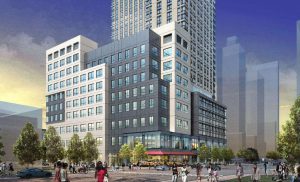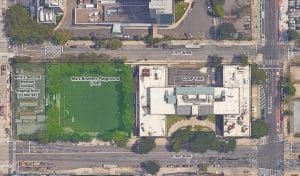From City Limits: A Must read for anyone who cares about Parkland. (Excerpt below)
Manhattan Parcel with Murky Origins Could Frame a Debate Over Parks and Development in the City
“Is the Marx Brothers Playground [Marx Brothers Playground—named after legendary comics Chico, Groucho, and Harpo who were raised at nearby 179 E 93rd St] on 2nd Ave between East 96th & 97th Streets a park or a playground?
To realize the scope of its blueprint, AvalonBay obtained City Council approval for changes to the site’s zoning, waivers for parking and open space requirements, and permission to build a higher tower in exchange for affordable housing—a newer tactic that required creating a Mandatory Inclusionary Housing (MIH) zone. The Marx Brothers Playground, however, presented a more complicated issue.
Back in 2004, when the MTA was authorized to stage its Second Avenue Subway necessities on a piece of the playground, the state law that temporarily permitted the takeover labelled the Marx Brothers as “park lands.” Now known as Chapter 543 of the State Laws of 2004, the bill directed the MTA to “restore the surface of the lands” when it was finished with its project and provide “replacement trees to be determined by the Parks Department” so that the “lands shall continue to be used for park purposes.” As a piece of protected parkland, then, the playground was exempt from all zoning laws and unable to generate useable floor area. A developer couldn’t build anything there.
So AvalonBay once again solicited the City Council for aid. In June 2017, the body voted in favor of asking the New York State Legislature to strip the playground of its parkland status. Called a “home rule request,” the resolution was quickly taken up by both the Assembly and Senate and approved. The playground was officially “alienated.”
 The residential tower will be the second tallest building on the east side
The residential tower will be the second tallest building on the east side
Now, as a regular lot, it was immediately subject to the laws of whatever zoning district had jurisdiction. Moreover, the changes that AvalonBay procured through ULURP also went into effect. The former playground now produced floor area. The ECF could officially take possession of the Marx Brothers-COOP Tech site and transfer it to the developer. Demolition and construction teams could finally emerge.
But after news broke of the Marx Brothers’ plan, stakeholders in the community like Carnegie Hill Neighbors [East Harlem Preservation are also opposed] and watchdogs like Geoffrey Croft at NYC Park Advocates got involved. In July, Carnegie Hill Neighbors, the non-profit group operating a few blocks west, appealed to Governor Cuomo to reverse the legislature’s decision. More groups followed its lead. In August, the Municipal Art Society, New Yorkers for Parks, and the Trust for Public Land sent off similar petitions (Change.org Petition too). …New York City mayoral candidate Sal Albanese and public advocate hopeful David Eisenbach staged a protest outside the playground on August 17th….
Parks. Playgounds. Both terms have a curious history of being used interchangeably. For example, when Seward Park on the Lower East Side was established in 1903, the Department of Parks and Recreation (DPR) observed that it was “equipped as a permanent playground.”
… Aren’t parks and playgrounds just the same thing?
It’s not just semantics. Depending on one’s take, these terms suggest—if not dictate—how the parcel of land is to be treated.
Historically speaking, the City has often claimed playgrounds as part of its park system. In doing so, it may have given them an “implied parkland” status. Under public trust doctrine, all that is necessary for a parcel of land to establish itself as a park is for it to have been “continuously used as a public park.” Moreover, as both the City has dedicated playgrounds for public use and its residents have accepted them as such, the notion of playgrounds as parks has solidified. You can see the idea at work in recent administrations.
In 1986, for example, as part of its Neighborhood Park Restoration Program, the Koch Administration touted spending $4.3 million to “refurbish” 144 Jointly Operated Playgrounds (JOPs). It added 600 workers to the DPR’s roster that year, including 248 “playground attendants.” The Times reported that “more than half of [them were placed] at the rehabilitated playgrounds” and quoted Jack Linn, Assistant Parks Commissioner for Government Relations, as justifying the deployment with this: “It makes sense to put your resources into defensible areas. You invest in something you can hold.”
On February 3, 1999, then Mayor Rudy Giuliani and DPR Commissioner Henry Stern issued a joint press release to celebrate an amazing accomplishment. They had brought the City’s total parkland to 28,000 acres, covering 14% of the five boroughs. “In the past five years,” the bulletin conveyed, “the Parks [Department]” had attained that milestone after “working with other City agencies…to identify potential parkland both for natural areas and neighborhood playgrounds.”
Under the Bloomberg Administration, the City was more explicit. When it released the 156-page tome called PlaNYC for a “greener, greater New York” in 2007, the administration was clear about its view of JOPs like the Marx Brothers Playground. “Today, there are 269 Jointly Operated Playgrounds open for public use,” the Plan read. “Since 1938, JOPs have been considered designated parkland, which restricts how the land can be used.” And, furthermore, when updating the City’s anti-smoking laws in 2011, the City Council not only banned smoking in “public parks,” it also defined what it meant by the term itself: “Park or other property under the jurisdiction of the department of parks and recreation’ means public parks, beaches, waters and land under water, pools, boardwalks, marinas, playgrounds, recreation centers and all other property, equipment, buildings and facilities now or hereafter under the jurisdiction, charge or control of the department of parks and recreation.”
The Marx Brothers Playground—whether originally parkland or playground—is now alienated and poised to supply its development rights to AvalonBay. Because of the de Blasio administration’s current position on the Marx Brothers, it is conceivable that other playgrounds, JOPs, or even parks themselves could have the potential to be alienated for their development rights. The risk is not new: The Bloomberg administration often worked parkland into development projects, from Yankee Stadium to Brooklyn Bridge Park to Flushing Meadows….”
The de Blasio administration is poised to go back on the promised park replacement (that never should have happened in the first place – re Bill Moyers Essay: Yankee Stadium – a scathing indictment from one of the most trusted voices in our country).

